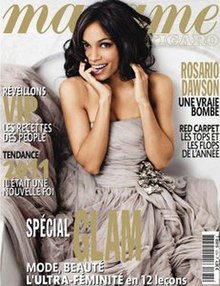Madame Figaro
 |
|
| Editors | Nicole Picart and Blanche Rival |
|---|---|
| Categories | Fashion, Women's magazine |
| Frequency | Weekly |
| Total circulation (2011) |
449,800 |
| Year founded | 1980 |
| Company | Le Figaro |
| Country | France (other editions worldwide) |
| Based in | Paris |
| Language | French (other editions worldwide in other languages) |
| Website | Madame Figaro |
| ISSN | 0246-5205 |
Madame Figaro is a French magazine supplement to the Saturday edition of the daily newspaper Le Figaro, focusing on and catering to women.
The first edition was published in 1980.Madame Figaro was spearheaded by Robert Hersant, who succeeded Jean Prouvost (creator of the French women's fashion magazine Marie Claire). The magazine experienced immediate success, owing to its diverse contents, and the quality of the writing, targeting affluent readers. The first female Editor-in-Chief of the magazine was Marie-Claire Pauwels, daughter of Louis Pauwels. The launch of Madame Figaro in 1980 marked a distinct distancing from the feminist movement of the preceding decade (notably from the movement to "liberate pornography" that had a goal of seizing power from the dominant moral and religious institutions). Madame Figaro had its origins as a single page feature appearing in Figaro Magazine, because that magazine's majority of readers were female, drawn to its orientation towards topics on culture and the art of living (l’art de vivre).Le Figaro publishes a number of other supplements, each on a particular day of the week, for example, an economic news supplement, a supplement for its Paris-region readers, and so on.
Madame Figaro is devoted solely to topics interesting to female readers. This has included such highly debated topics of the 1980s as: sexual relationships between men and women; aspirations towards equality between the sexes and to further women's emancipation; how to make families succeed during marriage; children and strong families.
Madame Figaro is a mainstream women's magazine, feminine and a vehicle for ideas that are both liberal and conservative, since the beginning of the 1980s. A vital part of "Madame Figaro's" content is its focus on enhancing women's careers, and challenging conventional views of women's roles in society.Madame Figaro was among the first news publications in France to publish feature-length articles on the condition of women in foreign countries, using its own journalists.
The worlds of fashion, beauty and interior design are the fundamental content of the magazine. Articles discussing elegance and distinction, all while taking a critical view of fashion's social conformity, have been hallmarks of the presentation of fashion in Madame Figaro.
...
Wikipedia
